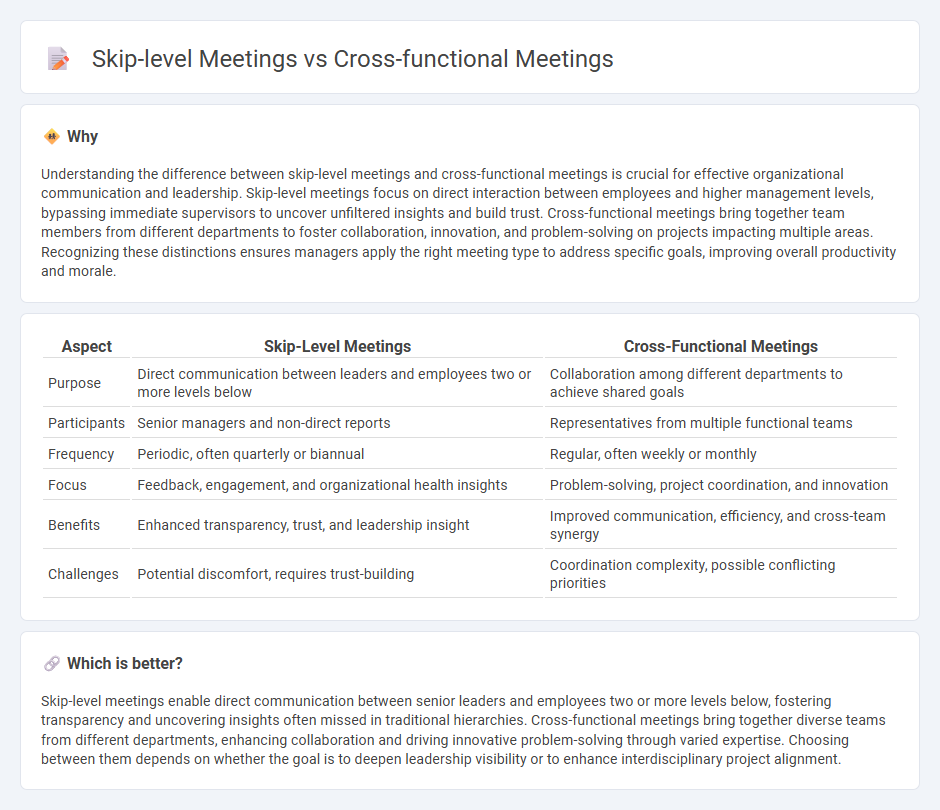
Skip-level meetings enhance organizational transparency by connecting employees directly with senior leaders two or more levels above, fostering open communication and uncovering critical insights beyond immediate team interactions. Cross-functional meetings unite representatives from diverse departments such as marketing, finance, and product development to drive innovation and solve complex problems through collaborative decision-making. Explore more to understand how these meeting types optimize management effectiveness and organizational growth.
Why it is important
Understanding the difference between skip-level meetings and cross-functional meetings is crucial for effective organizational communication and leadership. Skip-level meetings focus on direct interaction between employees and higher management levels, bypassing immediate supervisors to uncover unfiltered insights and build trust. Cross-functional meetings bring together team members from different departments to foster collaboration, innovation, and problem-solving on projects impacting multiple areas. Recognizing these distinctions ensures managers apply the right meeting type to address specific goals, improving overall productivity and morale.
Comparison Table
| Aspect | Skip-Level Meetings | Cross-Functional Meetings |
|---|---|---|
| Purpose | Direct communication between leaders and employees two or more levels below | Collaboration among different departments to achieve shared goals |
| Participants | Senior managers and non-direct reports | Representatives from multiple functional teams |
| Frequency | Periodic, often quarterly or biannual | Regular, often weekly or monthly |
| Focus | Feedback, engagement, and organizational health insights | Problem-solving, project coordination, and innovation |
| Benefits | Enhanced transparency, trust, and leadership insight | Improved communication, efficiency, and cross-team synergy |
| Challenges | Potential discomfort, requires trust-building | Coordination complexity, possible conflicting priorities |
Which is better?
Skip-level meetings enable direct communication between senior leaders and employees two or more levels below, fostering transparency and uncovering insights often missed in traditional hierarchies. Cross-functional meetings bring together diverse teams from different departments, enhancing collaboration and driving innovative problem-solving through varied expertise. Choosing between them depends on whether the goal is to deepen leadership visibility or to enhance interdisciplinary project alignment.
Connection
Skip-level meetings enhance communication by allowing managers to engage directly with employees two levels below, revealing insights that often inform cross-functional meetings focused on collaboration across departments. These meetings foster transparency and uncover operational challenges, enabling cross-functional teams to address issues with a more comprehensive understanding of the organization's inner workings. By combining vertical feedback from skip-level meetings with horizontal collaboration in cross-functional meetings, companies improve decision-making and drive strategic alignment.
Key Terms
**Cross-functional meetings:**
Cross-functional meetings bring together team members from different departments to foster collaboration, enhance problem-solving, and drive innovation by leveraging diverse expertise. These meetings improve communication channels across organizational silos, resulting in faster decision-making and aligned project goals. Explore more about how cross-functional meetings can boost productivity and team synergy.
Collaboration
Cross-functional meetings involve team members from different departments working together to solve problems and achieve common goals, enhancing overall collaboration and innovation. Skip-level meetings connect employees with their manager's manager, fostering open communication and trust while addressing concerns that might be overlooked in regular hierarchy-based meetings. Explore more to understand how these meeting types can optimize collaboration in your organization.
Diverse expertise
Cross-functional meetings harness diverse expertise by bringing together team members from various departments to collaboratively solve problems and foster innovation. Skip-level meetings involve direct dialogues between employees and higher-level managers, facilitating transparent feedback and strategic alignment across organizational layers. Explore further to understand how leveraging these meeting types can enhance your team's performance and communication.
Source and External Links
Best Practices for Managing Cross-Functional Project Meetings - This article provides best practices for organizing effective cross-functional meetings, including setting clear agendas, encouraging participation, and focusing on decision-making.
What are Cross-Functional Meetings? - This post explains the concept of cross-functional meetings, which involve diverse departments working together, and highlights their importance in structured collaboration.
What are Cross-Functional Meetings? - This resource discusses how cross-functional meetings bring together diverse skills and perspectives to foster innovation and problem-solving across different departments.
 dowidth.com
dowidth.com